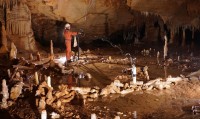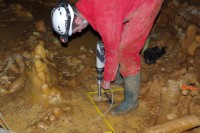 The entrance to the Bruniquel Cave in southwest France collapsed in prehistoric times, sealing off the cave from the Pleistocene until determined local speleologists dug their way through in 1990. Inside the cave just 336 meters (1102 feet) from the entrance, they found two circular structures made of whole and broken stalagmites. Archaeologists carefully documented the site, but were unable to date it. Accelerator mass spectrometry radiocarbon dating on a burnt animal bone found nearby returned a date of older than 47,600 years ago, which pushes the outer limit of C-14 dating’s 50,000-year range. The date dangled the intriguing possibility that the stalagmite circles had been built by Neanderthals, the only people in Europe from 400,000 to 40,000 years ago when anatomically modern humans moved in and rapidly took over.
The entrance to the Bruniquel Cave in southwest France collapsed in prehistoric times, sealing off the cave from the Pleistocene until determined local speleologists dug their way through in 1990. Inside the cave just 336 meters (1102 feet) from the entrance, they found two circular structures made of whole and broken stalagmites. Archaeologists carefully documented the site, but were unable to date it. Accelerator mass spectrometry radiocarbon dating on a burnt animal bone found nearby returned a date of older than 47,600 years ago, which pushes the outer limit of C-14 dating’s 50,000-year range. The date dangled the intriguing possibility that the stalagmite circles had been built by Neanderthals, the only people in Europe from 400,000 to 40,000 years ago when anatomically modern humans moved in and rapidly took over.
Archaeological exploration of the site ended abruptly when the lead archaeologist F. Rouzaud died prematurely in 1999, and the difficult access to the cave kept other archaeologists from picking up where he left off. In 2013, Royal Belgian Institute of Natural Sciences palaeoclimatologist Sophie Verheyden, a speleologist who has a vacation home in the area, put together a team of experts to examine the annular stalagmites structures.
 Verheyden’s team found two circular structures, the larger one 6.7 × 4.5 meters (22 x 15 feet), the smaller one 2.2 × 2.1 meters (7.2 x 6.9 feet). In the center of the larger circle are two stacks of stalagmites with two more accumulation structures outside of it. In total, about 400 stalagmite pieces were used in these structures, less than 5% of them whole. Half of them are from the middle section of the stalagmites. The ones used in the large circle have a mean length of 34.4 centimeters (13.5 inches); the ones in the smaller circle have a mean length of 29.5 cm (11.6 inches).
Verheyden’s team found two circular structures, the larger one 6.7 × 4.5 meters (22 x 15 feet), the smaller one 2.2 × 2.1 meters (7.2 x 6.9 feet). In the center of the larger circle are two stacks of stalagmites with two more accumulation structures outside of it. In total, about 400 stalagmite pieces were used in these structures, less than 5% of them whole. Half of them are from the middle section of the stalagmites. The ones used in the large circle have a mean length of 34.4 centimeters (13.5 inches); the ones in the smaller circle have a mean length of 29.5 cm (11.6 inches).
The annular geometry is too regular to be the product of random natural breakage, and relatively regular sizes of the stalagmites, larger in the larger circle and smaller in the smaller circle, are further evidence that this is deliberate construction. The possibility that they might have been cave bear nests is eliminated by the size and inner organization of the structures. Archaeologists also found prints left where some of the stalagmites were wrenched off the cave floor and traces of fire on all six structures, 57 reddened pieces and 66 blackened ones.
 Uranium-series dating of stalagmite samples and the calcite regrowth covering the structures returned dates of 175,200 to 177,100 thousand years. The dates of all the samples fell into this range. The stalagmite structures are therefore among the oldest firmly dated human constructions, and Neanderthals were the only humans in Europe at that time.
Uranium-series dating of stalagmite samples and the calcite regrowth covering the structures returned dates of 175,200 to 177,100 thousand years. The dates of all the samples fell into this range. The stalagmite structures are therefore among the oldest firmly dated human constructions, and Neanderthals were the only humans in Europe at that time.
The earliest surviving evidence of constructions by anatomically modern humans — collapsed circular structures made from mammoth bones or dear antlers — date to around 20,000 years ago. Indications of earlier Neanderthal building are limited to a few postholes and remnants of dry stone walls, but they cannot be conclusively attributed to Neanderthals or conclusively dated. The great archaeological gifts of the Bruniquel Cave, therefore, are the complexity and survival of the stalagmite circles and the repeatable, reliable direct dating.
This momentous find redefines our understanding of Neanderthal culture and abilities. From the research published in Nature, which you can read in its entirety here (pdf):
The attribution of the Bruniquel constructions to early Neanderthals is unprecedented in two ways. First, it reveals the appropriation of a deep karst space (including lighting) by a pre-modern human species. Second, it concerns elaborate constructions that have never been reported before, made with hundreds of partially calibrated, broken stalagmites (speleofacts) that appear to have been deliberately moved and placed in their current locations, along with the presence of several intentionally heated zones. Our results therefore suggest that the Neanderthal group responsible for these constructions had a level of social organization that was more complex than previously thought for this hominid species.
There’s a compilation of photographs and 3D animated flyover of the site in the video on this page. Alas, I cannot embed it because of cursed autoplay, but it’s well worth viewing.
One percent of my DNA suggests that, way back in the Wayback Machine, a homo sapiens and homo neanderthalensis made babies together. I’m glad the evidence is accumulating that Neanderthals weren’t the brutish apes they were once characterized as.
Golly. Is there any plausible estimate for the average N population in Europe over that time, 400,000 to 40,000?
I suppose that even if the pop was small, 360k years gives them ample time to do things that might just survive to our times. Caves are best, I suppose, because glaciers and rivers won’t often wipe them away. This find turns out to be south of the glacial limits anyway, I imagine?
I suppose one would want to be very sure that this isn’t a hoax perpetrated since 1990. Does the calcite regrowth rule that out?